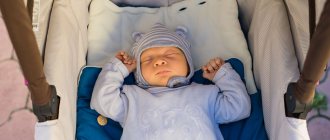When should you start walking?
A child needs fresh air from the first days of life. Therefore, it is recommended to start walking with your baby in suitable weather immediately after discharge from the maternity hospital. As a rule, in the warm season, walks can be recommended starting the very next day after discharge. In winter, the start of walks depends on weather conditions. Usually it takes 3-4 days for the baby to adapt and not go outside. But after this time and at the appropriate air temperature, walks can begin.
Walking with a newborn Komarovsky
Dr. Komarovsky, like all doctors in the world, advises not to deprive a newborn of the opportunity to breathe fresh air. Even before the baby is born, you should take care of the place where the baby will do this.
The ideal solution, according to the doctor, is a balcony if the house is multi-story. Where it should be clean and tidy. And it is not at all necessary for the mother to drag the stroller up the stairs, and after the walk, back to the apartment. It’s better to put the baby to bed and relax or get on with your business. In the same way you can protect your baby from viral infections.
The reason for walking on the street can be:
- going to the clinic
- need to go to the store
- walking together with dad and newborn
- no balcony
If there is no balcony, you can walk in the yard, not far from the house. It's not as convenient as on the balcony.
- You can start walking on the balcony as early as the tenth day after birth. The duration of the first walk should not exceed twenty minutes. The second walk will be ten minutes longer, and twice a day
- Gradually accustoming the baby, in a month he will actually spend the whole day on the balcony. In addition to feeding and changing times
- In summer, when the balcony is on the sunny side, you should avoid such walks and look for another suitable place
- In winter, no one canceled walks. You should start from -5 but not lower than -15 degrees
- Dress your baby according to your experience. If your baby is very sweaty after returning from a walk, then you should wear lighter clothes for the next walk.
IMPORTANT: The doctor advises you to enjoy the first months of your baby’s life and walks on the balcony. This is the time when a newborn sleeps almost all the time. And mom can relax and spend time with dad.
What weather is considered suitable for walking?
During the cold season, unsuitable weather conditions may limit your ability to stay outside. Thus, it is not recommended to walk with a child during the first 2 months of life at an air temperature below -10°C, as well as in the case of strong wind, rain, snowfall in combination with wind.
Temperatures below -15°C may be a restriction for walking a child over 2 months of age. At the same time, even positive air temperatures in the cold season, combined with strong winds, are unfavorable for going outside. Usually in this case it is recommended to sleep with the baby dressed for a walk on a glassed-in balcony or in a room with the window open.
In summer, very hot weather (for example, air temperature above +25°C), usually observed at midday, also serves as a reason for refusing to go for a walk. In this case, you can “wait out the heat” by changing your walking routine to a more comfortable one. Thus, it is known that in the morning and towards evening the sun becomes less active, and these are the hours that can be successfully used for walks with the baby.
Good sunny weather (in mid-latitudes it is usually observed from mid-spring to mid-autumn) is optimal for walking with your baby, if the air temperature is not higher than +25°C. But it must be remembered that the child should not be exposed to direct sunlight. This is especially true in summer, when the sun is most active. Thus, the best option for walking on bright sunny days is for the child to stay in the shade. In this case, the effect of exposure to sunlight on the child’s skin is also achieved, but it will not be as aggressive. In addition, the baby is less likely to overheat. Parents should be aware that due to the characteristics of children's skin (thinness, increased sensitivity and vulnerability), sunburn in children occurs very quickly. So, a child who has been exposed to bright sunlight for too long may experience redness of the skin and the appearance of blisters on it. The baby may be lethargic (or, conversely, restless), refuse to eat, and have a fever. The reaction to sunlight manifests itself in some children in the form of photodermatitis - redness of the skin, peeling, and the appearance of a rash on exposed areas of the body.
Basic rules for the first walk
You can walk with your newborn baby on the 7th–10th day, provided there is no wind, rain, extreme heat or frost. It largely determines how many days the first walk is allowed and the baby’s condition. The timing may increase if the baby is born ahead of schedule, or there were complications during childbirth.
In summer, you can go for a walk on the 7th day. How long should the first party last? Walking should be no more than 15 minutes a day. Gradually add 5-10 minutes. By the end of the week of walking, the time should be one hour. In the fresh air, the baby falls asleep and sleeps from 20 minutes to 1 hour. You should not leave your baby sleeping longer than this time. The risk of malnutrition or disruption of sleep patterns during the day and night increases.
How many days after birth are you allowed to walk in winter? In winter, walks with a newborn should begin no earlier than 14 days after birth. If the temperature in winter is below -10 degrees, then the first walk should be postponed. During frosts, you can take the child out to the balcony or open the window, after dressing the baby warmly.
How many days can you take your newborn for a walk in the fall? In spring and autumn, walks are allowed already on the 9th day of life.
What are the benefits of fresh air for a one month old baby? Several important points can be highlighted:
- Presence of ultraviolet rays. When they come into contact with a child’s skin, they begin to synthesize vitamin D, which prevents rickets.
- A high oxygen content helps normalize hemoglobin in the blood. As a result, all metabolic processes are improved and the development of respiratory failure is prevented.
- Development of body thermoregulation.
- Strengthening the immune system.
- Improved sleep and appetite.
After the sixth month of life, another reason to walk outside is added - getting new impressions, developing cognitive activity.
It is better to walk between feedings. The child will behave calmer, sleep more soundly, and in cold weather this will help him get used to the air faster. You definitely need to know the weather conditions. This will help you navigate your clothes. You need to dress your baby in such a way that he has several layers of clothing.
After the adult gets dressed, you can dress the child too. If you change the order of preparation, then a baby under the age of one year will sweat and with the slightest breeze on the street he will easily get sick.
A common way to walk is to take a stroller. But some children flatly refuse to lie in it. You can try another option - using a kangaroo, slings or a backpack.
To make your walk with your child enjoyable, no matter what time of year it is outside, you need to take the following things with you:
- a blanket and blanket (light for summer and warm for winter);
- a diaper or sheet if you plan to breastfeed in the summer;
- changeable diaper;
- a pacifier (if the child is used to sucking);
- handkerchief;
- wet wipes;
- raincoat, mosquito net;
- rattles
It is better to walk away from the roads. You can choose walks in the forest or park.
Duration of walks with the baby
How long the baby will be outside depends on his age and weather conditions.
If in the warm season the very first walks with the child can be quite long, reaching half an hour or even an hour by the 5-7th day of staying at home, then in the cold season the first walks (provided there is no wind and the temperature is not lower than -10° C) take 10-15 minutes, with a subsequent increase in their duration to 40-60 minutes over several days (the duration of the walk is increased by 5-10 minutes every day). This approach allows the child to gently adapt to street conditions. When the process of walking becomes habitual for parents and the baby (usually this happens by the 1st month of life), then in the warm season for children in the first months of life, the duration of the walk can reach 2-2.5 hours (this corresponds to the break between feedings). So, by 3-4 months the baby should walk at least 2 times a day for 1.5-2 hours. Approximately the same duration of walks is optimal for older children.
Sometimes in the warm season, babies in the first months of life manage to eat (i.e. suck the breast) even during a walk, in which case its duration (if it does not tire the mother or the whole family) can be even longer. It is better if the baby walks twice a day - in the morning and in the evening. Thus, he will spend quite a lot of time outdoors.
In cold weather, the duration of a walk for children under 1 year old, as a rule, should not exceed 1 hour. You can walk with your baby for a shorter period of time, but do it 2-3 times a day.
You should adhere to a certain daily routine. This means that you need to go for a walk with your child at approximately the same time.
How long should you walk with a nine-month-old baby in winter?
In principle, after six months of age, the duration of winter walks does not increase, and the air temperature does not need to be changed. True, if the winter turned out to be warm or, on the contrary, very cold, then these indicators can be varied somewhat.
At the age of 9 months, the baby is already fully aware of what is happening and watches people, animals and nature with interest - you should not combine a walk in the fresh air with sleep. But being outside, coupled with acquiring new knowledge and skills, will be very helpful. You can tell your baby what snow is, show how white and fluffy it is, and sledding (only if the child sits confidently!) - entertainment for such a small child can be found even in winter.
How long to walk with a 9-month-old child - not a single pediatrician will give an exact answer to this question. In general, at this age the child already has some desires and needs of his own, so parents will have to adapt to them. For example, a baby may want to sleep right after lunch, which means the walk will have to be postponed. Another option is that too much exercise leads to a strong feeling of hunger in the child, so it is not recommended to go far from home. At the age of nine months, the child is often taken out for walks while still wearing a diaper, so do not forget about using a protective baby diaper cream.
So, we figured out how and how long to walk with a child in winter. But when can you not take your baby outside? Firstly, if he is not feeling well - for example, the baby is teething, he is worried and capricious, and often cries. It is unlikely that a walk will distract the child from his condition, but adding a cold is quite possible - during the period of teeth growth, every child’s body is weakened, his immune system works in a “light mode”, so a walk can turn into a cold.
Secondly, you should not walk with your child in the first two days after vaccination (any) - again, the child’s body has directed all its forces to fight the introduced virus and is unlikely to be able to adequately respond to an additional attack of infection.
Thirdly, it is not advisable to walk with a child in winter if the air temperature has dropped below 15 degrees below zero, but even at this temperature you can take it outside - only a baby aged 9 months or older.
What should I dress my child in?
The principle of selecting clothing is based on its suitability to weather conditions. If it’s hot outside, the baby can be dressed in a bodysuit (or blouse). Very young children are usually covered with a light diaper. Accordingly, cooler weather requires that the baby wear rompers, additional blouses, a suit and a hat. More convenient are modern overalls, which replace several things at once and are convenient for quickly dressing a child. Overalls can be winter, demi-season and very light (made of thin knitwear, so-called slip overalls).
Winter overalls in combination with a sleepsuit or blouse and rompers are used at air temperatures below +5°C.
Some mothers prefer to use envelopes for walking with their children in the first weeks of life. Envelopes also come in different varieties - from a lightweight version (for example, made from fleece fabric) to a rather warm, fur one.
How to dress a baby for a walk
Young children often become hypothermic. In the first two months of life, it is important for a newborn to have a minimum of clothing-free areas of the body. A solid jumpsuit or slip that will reliably cover the back and stomach will help solve this problem. And if you are going to a store or clinic, you can use an envelope that can be easily removed and undressed if necessary.
You need to dress your baby in several layers. This will help to cover the baby’s body as much as possible and ensure a comfortable temperature. But at the same time, the baby must move freely. Choose clothes only according to your baby's size. It is important that it does not restrict movement, but is not too loose and does not leave bare areas of the body.
Choose clothes, especially the lower layers, from natural fabrics, as they will provide the skin with normal access to oxygen. Therefore, the child will not freeze or overheat. In addition, natural materials rarely cause allergies in infants. It is important that the clothes are safe for the newborn and do not damage the delicate skin. Therefore, take clothes without metal buttons and rough seams, narrow elastic bands and snaps. For children under two months old, take underwear and underwear with the seams facing out.
While the child is lying down and not actively moving during a walk, dress the baby as yourself plus one layer, and as soon as the child walks on his own, runs, jumps - as himself minus one layer.
In summer and spring, infants often develop rashes, skin irritation and diaper rash.
Therefore, in warm weather, dress your baby in light clothing that will allow the skin to breathe. In winter, to prevent your baby from freezing, be sure to use warm overalls and an envelope, a cotton cap and a warm hat. In severe frost, wrap your child in a warm wool blanket. And first dress yourself, and then dress your baby. The child should not sweat while waiting for you! Subscribe to our VKontakte group
How can you tell if your baby is cold or hot?
If the baby’s nose remains warm during a walk and, upon returning home, the child’s hands and feet are also warm to the touch, we can talk about comfortable temperature conditions for the walk.
If the baby's hands and feet are cool, the baby should be warmed up as quickly as possible - for example, by wrapping him in a blanket, carrying him in your arms, holding him tightly to you, or giving the baby a warm bath.
On the contrary, wet blouses, a hat, diapers, or wet baby hair after a walk can be a signal that he was too hot. Such children may be restless during a walk and often wake up.
What is the reason for the importance of walking with an infant?
In fact, there are many reasons for this.
- Firstly, outside the baby’s body is better saturated with oxygen. This helps the flow of metabolic processes and also prevents the development of respiratory failure in the child.
- Secondly, the baby’s skin needs ultraviolet light. It promotes the production of vitamin D, which is so necessary for the baby to prevent rickets.
- Thirdly, the baby’s stay outside trains and improves the thermoregulation of the child’s body.
- And, fourthly, children with whom they walk daily are less likely to catch colds, sleep and eat better.
Necessary little things
“Rain covers” or additional stroller hoods prove necessary in inclement weather. Their use allows you to walk in light rain or snow. But they should not be used unless absolutely necessary, in good weather. If the stroller is covered, a “greenhouse” effect is created inside it, and the circulation of fresh air near the child’s face becomes minimal. Accordingly, the benefits of such a walk will be in doubt.
In summer, if there are mosquitoes, a mosquito net can be useful.
First walk with a newborn in autumn and spring
The autumn-spring period is very changeable in weather conditions, and is also the season of viral infections. The first walk during this period should be taken very seriously. If the weather outside is good, sunny and without wind, then you can safely go out for ten minutes. The next day, add another ten minutes to your walk. Gradually increasing the walking time.
IMPORTANT: If it’s raining outside, it’s better to avoid walking. You can, of course, cover the stroller with a raincoat. But there will be little benefit from such a walk; the baby will not have access to fresh air.
When you can't go for a walk...
In such cases, an alternative to a walk is to sleep with the window open, on a glazed veranda or balcony (under the constant supervision of parents, preferably using a radio or video baby monitor!) or in a well-ventilated room (if it is very cold outside and with the window open the baby may freeze). The balcony must be glazed if it is used for walks with the baby, since something thrown from the upper floors, including a cigarette butt, may fall onto the open balcony or loggia, a bird may fly in, and a strong wind may blow leaves and dust that you may not immediately notice.
When should you go for your first walk?
If your baby was born in the summer , you can go for a walk with him on the 10th day of life. It is by this time that the adaptation period of most newborns ends.
If the baby was born in winter , doctors recommend going for a walk on days 10-14. But don't rush! Make sure it is at least -10 outside and there is no wind. If this is not the case, it is better to wait until it gets a little warmer, but in the meantime you can wrap your baby warmly and open the window while he sleeps. 15 minutes before the expected awakening, the windows must be closed so that the temperature in the room returns to normal.
How long to walk with a baby aged one month or older?
So, by the month the duration of walks at temperatures down to -15° without wind can be about 1.5 hours. You can walk longer with an older toddler: up to 2 hours. Some children happily sleep outside for 2-3 hours in winter.
Very young children sleep throughout the walk, older children can sleep through part of the walk, and spend the rest of the time admiring the beauty of their home yard or the nearest park. In any case, the main thing is that the baby is dressed for the weather. The same applies to an adult who walks with a baby.










